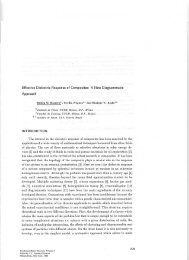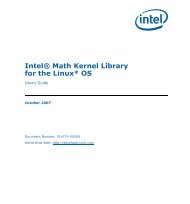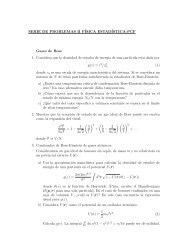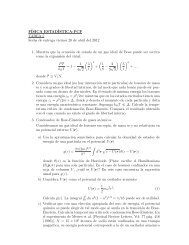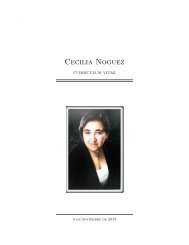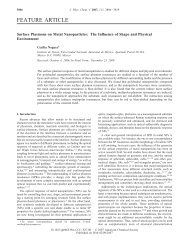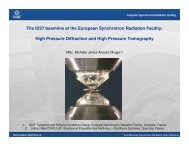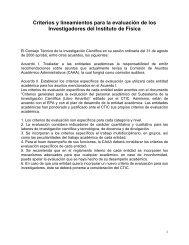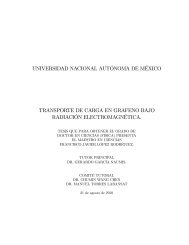Absolute values of transport mean free path of light in non-absorbing ...
Absolute values of transport mean free path of light in non-absorbing ...
Absolute values of transport mean free path of light in non-absorbing ...
You also want an ePaper? Increase the reach of your titles
YUMPU automatically turns print PDFs into web optimized ePapers that Google loves.
264 J. GALVAN-MIYOSHI AND R. CASTILLO<br />
If P (q) and S(q) are known, l ∗ can be determ<strong>in</strong>ed us<strong>in</strong>g<br />
Eq. (B.1). To give an estimate, we calculated P (q) with Mie<br />
theory for a <strong>non</strong>-absorb<strong>in</strong>g spherical particle immersed <strong>in</strong> a<br />
<strong>non</strong>-absorb<strong>in</strong>g medium us<strong>in</strong>g:<br />
with<br />
P (θ) = k 2 �<br />
oσdiff (θ) = π |S1 (θ)| 2 + |S2 (θ)| 2�<br />
,<br />
S1 (θ) =<br />
S2 (θ) =<br />
∞�<br />
n=1<br />
∞�<br />
n=1<br />
(2n + 1)<br />
n (n + 1)<br />
× [anπn (cos θ) + bnτn (cos θ)] , (B.2)<br />
(2n + 1)<br />
n (n + 1)<br />
× [anτn (cos θ) + bnπn (cos θ)] . (B.3)<br />
Here, τn (cos θ) = (d/dθ)P 1 n (cos θ) and<br />
πn (cos θ) = P 1 n (cos θ)<br />
,<br />
s<strong>in</strong> θ<br />
with P 1 n (cos θ) the Legendre polynomials, and an and bn coefficients<br />
determ<strong>in</strong>ed by the boundary conditions.<br />
S(q) can be calculated for a system <strong>of</strong> hard spheres us<strong>in</strong>g<br />
Percus-Yevick closure [16], which gives:<br />
∗. Author to whom correspondence should be addressed: e-mail:<br />
rolandoc@fisica.unam.mx<br />
1. D.A. Weitz, D.J. P<strong>in</strong>e <strong>in</strong>: Dynamic Light Scatter<strong>in</strong>g, W. Brown<br />
(Ed.). (Oxford University Press, New York, 1993) Chap. 16, p.<br />
652.<br />
2. J.L. Harden and V. Viasn<strong>of</strong>f, Curr. Op<strong>in</strong>. Colloid. Interface Sci.<br />
6 (2001) 438.<br />
3. D.J. P<strong>in</strong>e, D.A. Weitz, P.M. Chaik<strong>in</strong>, and E. Herbolzheimer,<br />
Phys. Rev. Lett. 60 (1988) 1134.<br />
4. F. Scheffold, J. Dispersion Sci. and Technol. 23 (2002) 591.<br />
5. L.F. Rojas-Ochoa, D. Lacoste, R. Lenke, P. Schurtenberger, and<br />
F. Scheffold, J. Opt. Soc. Am.A. 21 (2004) 1799.<br />
6. S. Mitani, K. Sakai, and K. Takagi, Jpn. J. Appl. Phys. 39<br />
(2000) 146.<br />
7. N. Garcia, A.Z. Genack, and A.A. Lisyansky, Phys. Rev. B. 46<br />
(1992) 14475.<br />
1<br />
S(q)<br />
p1<br />
= 1 + s<strong>in</strong> (2q) − 2q cos(2q)<br />
q3 − p2<br />
q3 �� �<br />
1<br />
− 2 q cos(2q) + 2 s<strong>in</strong>(2q) −<br />
q2 1<br />
�<br />
q<br />
�<br />
3<br />
+ φp1<br />
2q 3<br />
− φp1<br />
2q 3<br />
�<br />
2<br />
+ 4<br />
q3 �<br />
where p1 = 3φ(1+2φ)2<br />
(1−φ) 4<br />
Rev. Mex. Fís. 54 (3) (2008) 257–264<br />
�<br />
1 − 3<br />
2q 2<br />
1 − 3 3<br />
+<br />
q2 2q4 and p2 = (3φ)2<br />
2<br />
Appendix C. Estimation <strong>of</strong> α ∗<br />
� �<br />
s<strong>in</strong>(2q)<br />
� �<br />
q cos(2q) , (B.4)<br />
(2+φ) 2<br />
(1−φ) 4 .<br />
α ∗ = zo/l ∗ can be estimated us<strong>in</strong>g a DWS experiment by fitt<strong>in</strong>g<br />
the <strong>in</strong>tensity autocorrelation function for the back scattered<br />
<strong>light</strong> from a colloidal suspension made <strong>of</strong> particles <strong>of</strong><br />
the same size as those to be used <strong>in</strong> the fluid to be <strong>in</strong>vesti-<br />
gated [4], us<strong>in</strong>g the expression:<br />
�<br />
(g2(t) − 1) pol = β exp<br />
−2γpol<br />
� �<br />
6t<br />
. (C.1)<br />
τ<br />
Here, the subscript pol is used to <strong>in</strong>dicate the polarization detection<br />
used <strong>in</strong> the experiment, V V for parallel and V H for<br />
cross polarization. Here, τ = � k2 oD �−1 is the relaxation time<br />
and D is the diffusion coefficient, and γpol = α∗ pol + 2/3. As<br />
D is known, α∗ ≡ 〈α∗ 〉 = (α∗ V V + α∗ V H ) /2 can be determ<strong>in</strong>ed<br />
from a fitt<strong>in</strong>g.<br />
8. J.W. Picker<strong>in</strong>g, C.J.M. Moes, H.J.C.M. Sterenborg, S.A. Prahl,<br />
and M.J.C. van Gemert, J. Opt. Soc. Am. A 9 (1992) 621.<br />
9. J.W. Picker<strong>in</strong>g, S.A. Prahl, N. van Wier<strong>in</strong>gen, J.F. Beek,<br />
H.J.C.M. Sterenborg, and M.J.C. van Gemert, App. Opt. 32<br />
(1993) 399.<br />
10. P.D. Kaplan, M.H. Kao, A.G. Yodh, and D.J. P<strong>in</strong>e, Appl. Opt.<br />
32 (1993) 3828.<br />
11. A. Ishimaru, Wave Propagation and Scatter<strong>in</strong>g <strong>in</strong> Random Media<br />
(Academic Press, New York, 1978).<br />
12. H.C. van de Hulst. Light Scatter<strong>in</strong>g by Small Particles (Dover,<br />
New York, 1981).<br />
13. G.K. Batchelor, J. Fluid Mech. 74 (1976) 1.<br />
14. J.X. Zhu, D.J. P<strong>in</strong>e, D.A. Weitz, Phys. Rev. A 44 (1991) 3948.<br />
15. L.F. Rojas-Ochoa, S. Romer, F. Scheffold, and P. Schurtenberger,<br />
Phys. Rev. E. 65 (2002) 051403.<br />
16. M.S. Wertheim, Phys. Rev. Lett. 10 (1963) 321.




